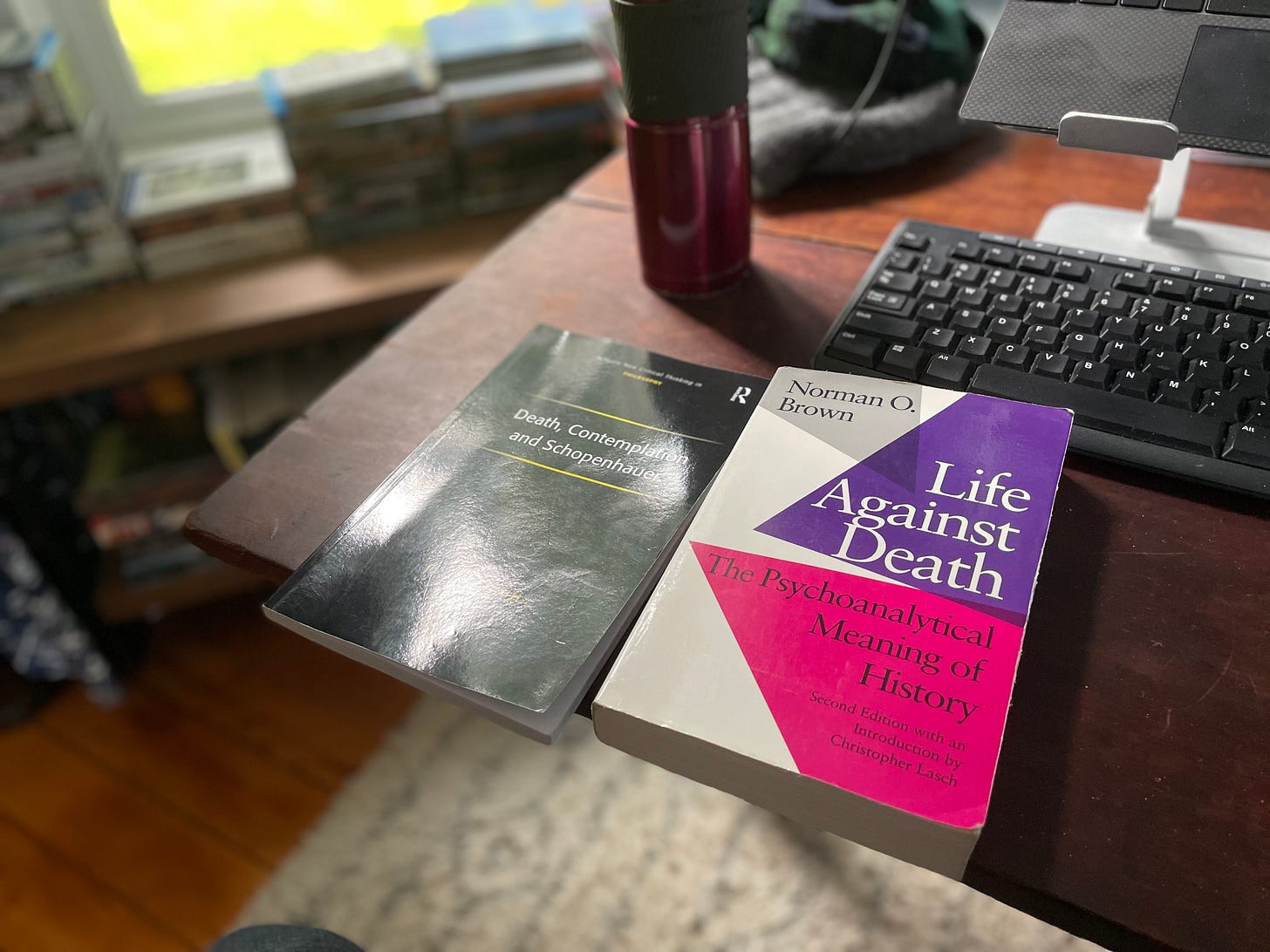Two lesser books on life and death
“Life Against Death: The Psychoanalytical Meaning of History”, by Norman O. Brown; and "Death, Contemplation and Schopenhauer", by R. Raj Singh
It is strange, in some sense, to refer to either of these works as “lesser”.
For example, Norman O. Brown’s “Life Against Death” is generally regarded as a mid-century, landmark work. It laid waste to the two primary currents in psychoanalysis that developed after Freud’s death: the Freudian orthodoxy on the one hand that transformed psychoanalysis from a living science into a calcified doctrine; and the Neo-Freudian offshoots on the other hand that rendered Freudian psychoanalysis palatable to the mainstream by eliminating everything about it that was controversial or shocking. Furthermore, Norman O. Brown’s work, which ends with an impassioned plea for the unrepressed life, is seen to have both legitimized and galvanized the growing clamor for a hippy, “free love” lifestyle and counter-cultural movement. Clearly, it’s a pivotal work. In what sense could this book be “lesser”?
R. Raj Singh’s work, “Death, Contemplation and Schopenhauer”, has not gained any of the fame (or infamy) of Norman O. Brown’s magnum opus. And yet I still feel odd at referring to this sort of work as “lesser” too. “Death, Contemplation and Schopenhauer” explores the fascinating intersection between thanatology, ancient Greek philosophy, eastern religion, and Schopenhauerian metaphysics. It exposes the increasing engagement and entanglement in Schopenhauer’s oeuvre with his own evolving comprehension of Vedanta Hinduism and Hinayana Buddhism. And it highlights, from multiple perspectives, cultures, and epochs, the nature of death-contemplation, and it’s relation to life and metaphysics. This book is deep, if small. So how could it be lesser?
I would place these books in the upper echelons of my personal library. They are fascinating and important works, and the authors deserve the utmost praise for their efforts. I only say that they are lesser relative to the other books on those shelves. They are important works, to be sure, but they lack the overwhelming coherence and depth and force of their neighbors.
Norman O. Brown’s work, for example, is wide-ranging yet sprawling. It’s examination of repression, sublimation, and anality is expansive. Its deep tangents into the anality of Martin Luther, the founder of Protestantism, and Jonathan Swift, the author of Gulliver travels, are fascinating and ultimately illuminating. But there are limits to the number of tangents and extrapolations that an author can make. Beyond these limits, they risk the coherence of their work. And that’s exactly what Norman did. Although he makes a concerted effort in Part 1 of the book (about repression) to make clear both the basic conceptual underpinnings of repression as well as the interconnections between that foundation and its many-faceted manifestations, he increasingly forgoes that coherence as the book wears on. By the time we get to Part 3, about anality, Norman begins to jump so far afield that it’s hard to understand, even under the principle of charity, exactly how he could justify some of his assertions. Life Against Death is a monumental work. But it is also flawed one. In it we get depth, but not a coherent level of breadth. It promises too little and delivers too much.
R. Raj Singh’s “Death, Contemplation and Schopenhauer” suffers from the inverse. His work dives right to the heart of the human condition, from its very opening paragraph. It exposes fascinating connections between thinkers as diverse as Socrates, Heidegger, and Schopenhauer, on the one hand, and the critical commentaries of Vedanta Hinduism and Hinayana Buddhism on the other. But the limitations of this work are in its length. The author is constantly skimming the surface of these diverse disciplines. We get breadth, but not a satisfying level of depth. It promises too much and delivers too little.
I gladly recommend these works to any of my readers here. (Although I will admit that “Life Against Death,” which I read while on vacation last month in Scotland, made for some rather odd, and occasionally awkward, reading material at times. Perhaps a book that covers topics such as castration complexes and the relationship between human excrement and money is not the best choice for a family vacation). I only caution that, if your time is limited, that you perhaps choose first some of the other books from my reviews that I have given unequivocal praise to. For example, if I had to choose between recommending Ernest Becker’s “The Denial of Death” and Norman O. Brown’s “Life Against Death” — I would recommend former every time. “The Denial of Death” is a mind-blowing and unbelievably superior work. Similarly, if I had to choose between Dennis Vanden Auweele’s “The Kantian Foundation of Schopenhauer’s Pessimism” and R. Raj Singh’s “Death, Contemplation Schopenhauer”, I would also choose the former. Aweele’s work is without parallel in its richness of insight — an incredible feat in and of itself, but especially in light of its rather short length (242 pages). Also, in case you are wondering how I found the two works reviewed here, it was from following the footnotes of “The Denial of Death” (in the case of “Life Against Death”) and “The Kantian Foundations of Schopenhauer’s Pessimism” (in the case of “Death, Contemplation and Schopenhauer”).




